Washingtonia robusta
Belonging to a group of plants known as the fan palms, Washingtonia robusta, aka Mexican fan palm, is the largest of all of them.
As the name suggests, this titanic tree is native to Baja, California and west into the Mexican state of Sonora.
Despite its relatively narrow native range, this beloved behemoth is grown the world over in arid, sunny climes from San Diego to Dubai to the Cote d’Azur in France.
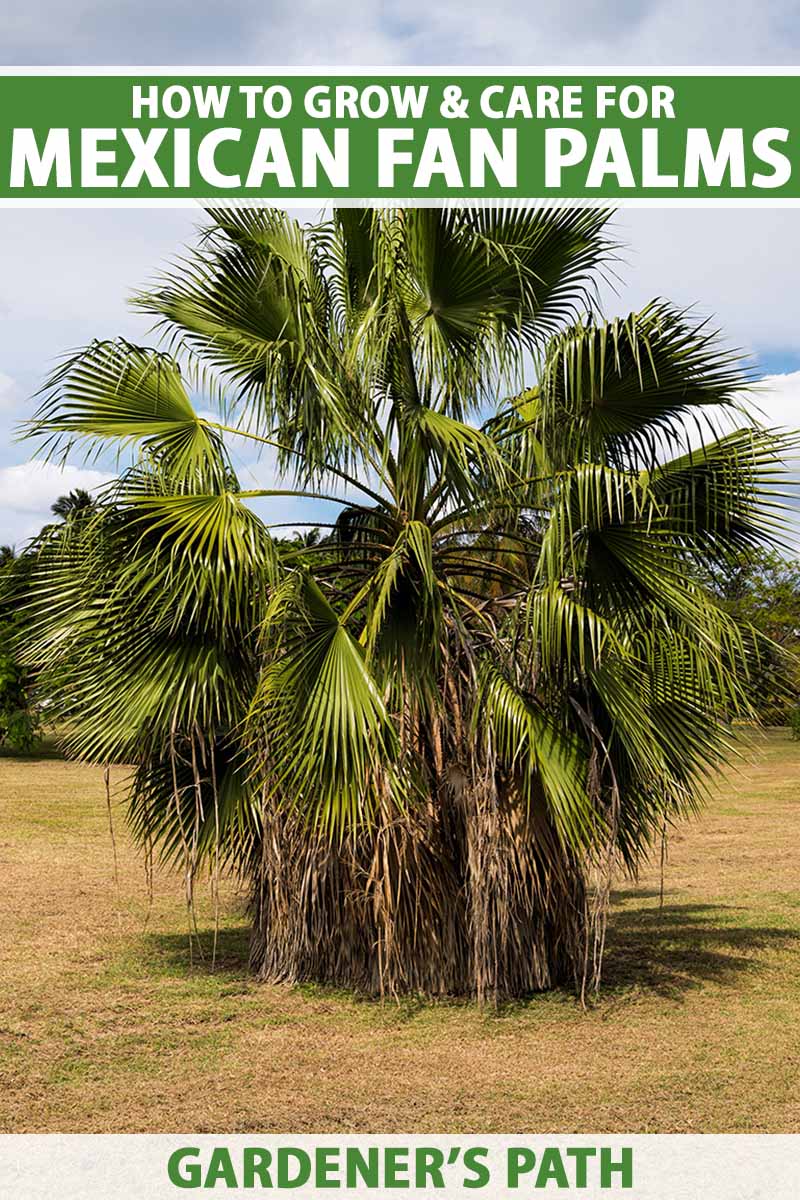
We link to vendors to help you find relevant products. If you buy from one of our links, we may earn a commission.
All fan palms love warm weather and W. robusta is no different. This species is eager to grow and is capable of putting on four feet of growth in a single year.
You can learn more about how to grow fan palms in our guide.
If you live somewhere with ample sun and minimal cold weather, read on to find out more about growing your own Mexican fan palm.
And for those of you with a brightly lit corner indoors, never fear! You can take a crack at growing this beautiful specimen inside as well.
Here’s what we’ll cover:
What You’ll Learn
Cultivation and History
Native to the Sonoran desert and Baja, Mexico, this drought-resistant palm can grow to 100 feet tall.
The crown bears a dense cluster of glossy, green leaves, each about five feet wide and shaped, as the name suggests, like a pleated fan.

The foliage is arranged in a tuft at the top of a tall, unbranched trunk, making it look like a giant upside down mop. It’s this somewhat comical appearance that gave it its common name, “skyduster.”
The genus name, Washingtonia, is a dedication to General George Washington. Dr. H Wendland, a prominent botanist in the late 1800s, bestowed this name on the genus and had to fight to hold onto it.
The famous moniker was in high demand and the group of trees known as sequoias almost laid claim to it.
Mexican fan palm is cultivated in the warm soils of Australia, Hawaii, the Middle East and beyond. It’s easy to grow, drought tolerant once established, and reliably bears clusters of attractive, dark colored fruit.
Hardy in USDA Zones 9 to 11, this species can tolerate temperatures down to 20° F, but not for extended periods. Persistent cold weather, especially cold wet weather, will damage foliage and invite disease.
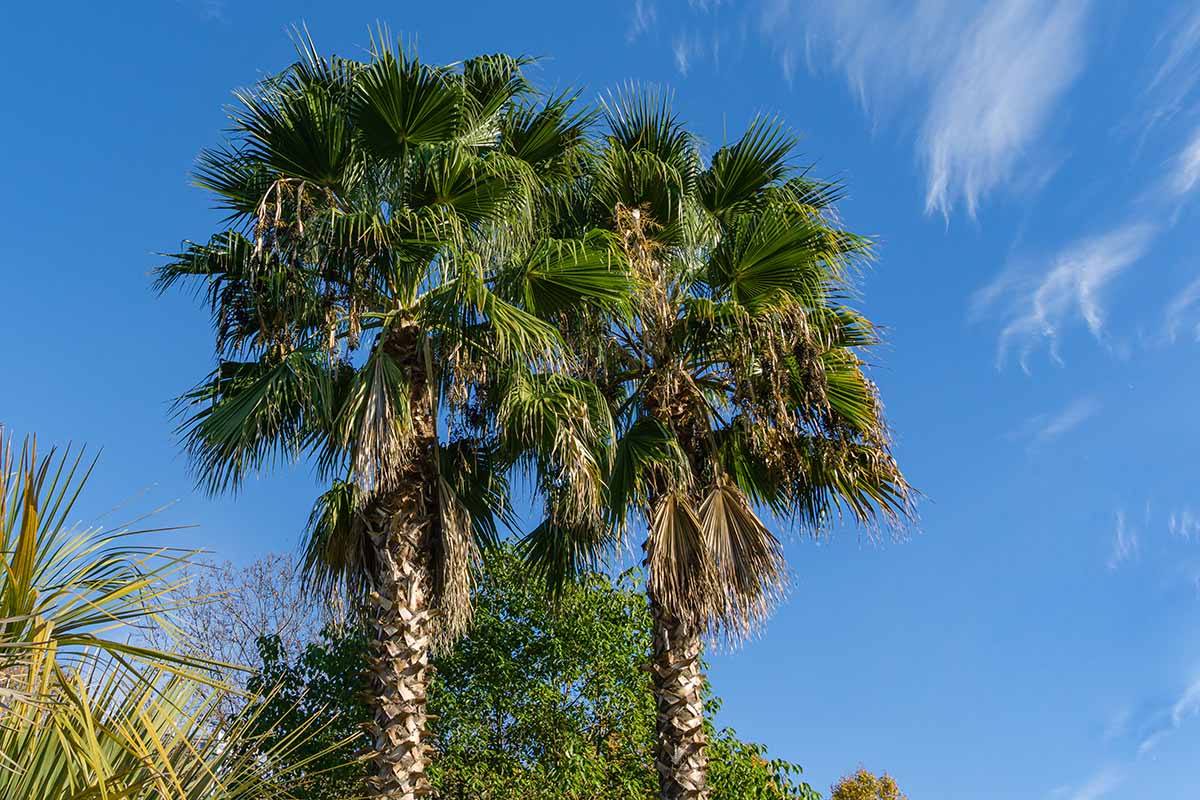
In its native habitat, Mexican fan palm provides nesting and shelter sites for birds, mammals, and insects.
Outside of its endemic range, W. robusta is listed as an invasive species in some places, such as California.
The California Invasive Plant Council has also labeled this tree a fire hazard, due to its tendency to accumulate dead, dry fronds along its trunk.
A popular houseplant gracing the well-lit confines of many an office, waiting room and home, Mexican fan palm does well indoors too.
Although it hails from the enviably sun-drenched coast of Mexico, it’s a tough cookie, and can manage conditions inside, too.
So you see, you’ve got options. Read on to learn how to start growing now.
Mexican Fan Palm Propagation
Like all true palms, W. robusta is grouped into a category of plants called “monocots.”
Monocots have parallel leaf veins, only one seed leaf instead of two, and produce flowers with petals in multiples of three.
This category of plants by and large do not grow lateral stems – they only grow upwards. For this reason, they won’t grow from cuttings.
To propagate W. robusta, you’ll have to start from seed or purchase a transplant.
From Seed
Fortunately, W. robusta is pretty easy to start from seed. If you’re a novice germinator, this species is a fun and rewarding one to try.
Seeds can be purchased online or harvested straight from the tree once fruits turn dark purple to black, indicating ripeness.
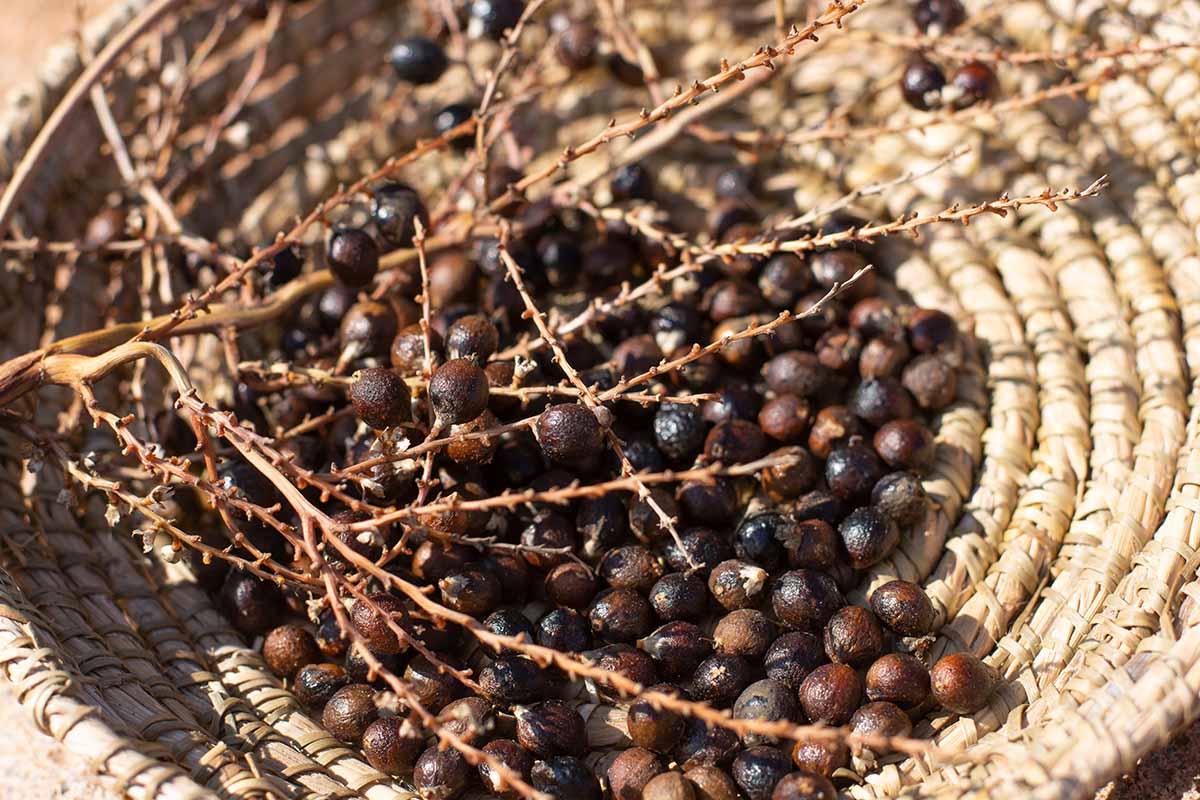
Try to remove all pulp from around the seed before you sow. Scrape off the fruit with your fingernails or the rough side with a sponge. This cleaning process helps keep unwanted fungal spores out of the planting substrate.
Once they are clean, soak the seeds in warm water for two to three days. This will help soften the seed coat and speed up germination. Change the water every day.
The cup containing the seeds should be placed on a heat mat or in bright sun to maintain a lukewarm water temperature. You don’t have to be too precise, just make sure it’s comfortably warm to the touch.
Sow seeds just below the surface of the soil in freely draining potting soil in four-inch pots. This species needs a little light to germinate, so make sure to not cover the seeds too deeply.
Sow a three or four seeds in each four-inch pot, you can separate out the strongest and best seedlings once they’ve germinated.
There are soil mixes formulated specifically for palms and it is best to use one of these.
Try this one, from Soil Sunrise, available on Amazon in eight-quart bags.

Put the pots in bright light, on a warm sunny windowsill, or on a heat mat. Maintain a temperature of somewhere around 80 to 90°F.
Keep the soil consistently moist, but not soaking, until germination occurs. This should take a week or two.
To take proper care of newly germinated seedlings, make sure the soil stays moist but not soaking wet in between waterings.
Once your plants have produced true leaves, pot them into larger containers and slow down the watering a little bit. Getting to this stage will take a few weeks.
Generally speaking, you want young plants to be in containers that are just large enough to give them a little extra room to grow. Potting your young palms into individual four-inch pots at this stage will suffice.
At this point, you can let the surface of the soil dry out a little before watering again.
You can learn more about how to start palms from seed in our growing guide.
Transplanting
If you’re transplanting the babies you grew from seed, make sure they have at least two true leaves before moving them.
True leaves will resemble the mature plant’s leaves, but be a bit smaller. If you’re planning to grow your plants outside, expose your babies to the sun and wind gradually, increasing their exposure each day by hour long increments.
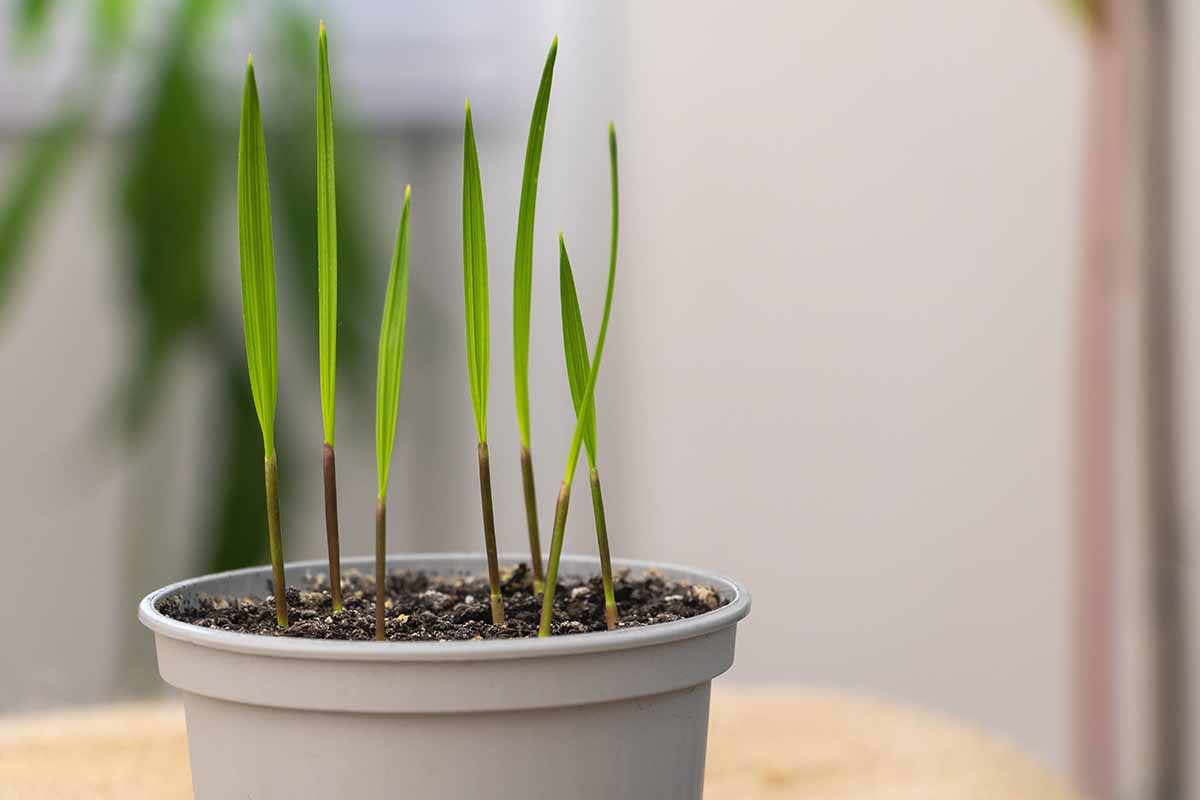
The same goes for any plant you purchased at a nursery. Make sure it is properly hardened off before planting outside.
In the garden, choose a spot in full sun with freely draining soil. This species likes relatively neutral soil, so keep the pH level somewhere around 6.0 to 7.0. If your site has a little afternoon shade, don’t worry, that will work too.
Try not to disturb your plant’s root ball too much when you dislodge it from the pot. This will give your new tree a better chance at survival.
Dig a hole a little wider than the root ball and set the plant so the top of the root ball is level with the ground.
Water thoroughly, at least once a week, until your palm shows signs of establishment, such as the emergence of new growth. This can take a few weeks to a few months.
Once these plants are established they are typically drought resistant but will need supplemental irrigation during dry spells.
If you’re transplanting into a pot, use a ceramic one with drainage holes in the bottom. You can opt to use plastic but you want your pot to be heavy enough to support the palm as it grows and not topple over easily.
Fill your container with palm tree potting soil up to the base of your transplant’s stem and water well. Pots dry out very quickly, and making sure new transplants have plenty to drink is critical to their success.
Keep the soil moist until your plants begin to grow new leaves. Allow the surface of the soil to dry out a bit, while the interior soil maintains some moisture.
Finding this sweet spot will give your new plant the hydration it needs while it grows, but prevent it from suffering from root rot.
W. robusta grows quite rapidly so make sure to pot up into larger containers as needed, always taking care to disturb the roots as little as possible.
Choose a new container that has about two inches of extra space around the existing root ball so it has plenty of room to grow.
How to Grow Mexican Fan Palms
The Mexican fan palm comes from warm, sunny climes and it expects no less when growing in your garden or gracing your home.

Keep this species in freely draining soils, give it ample sunlight, and plenty of space to grow, and it will not disappoint. Even if you’re starting with seedlings, this tree will need up to 25 feet of space between it and its neighbor when planted outside.
Make sure to choose a location where your full grown tree will not be exposed to high winds. As you can imagine, these tall trees, once full grown, can be toppled quite easily in strong winds.
Hardy in USDA Zones 9 to 11 W. robusta can actually tolerate dry cold quite well.
At 20°F, this species will survive, but may suffer damage to the foliage. Persistently cold, wet weather is much more damaging to this tree and will inevitably cause fungal infections.
Although these trees will tolerate a wide variety of soil types from loam to sand to clay, the substrate must be free draining. This species is also moderately salt tolerant, so if you happen to be within walking distance to the ocean, that salty sea air won’t pose a problem.
Consider the fact that if you keep your palm tree happy, it could grow several feet in a year. Make sure it lives somewhere that won’t cramp its high-flying style.
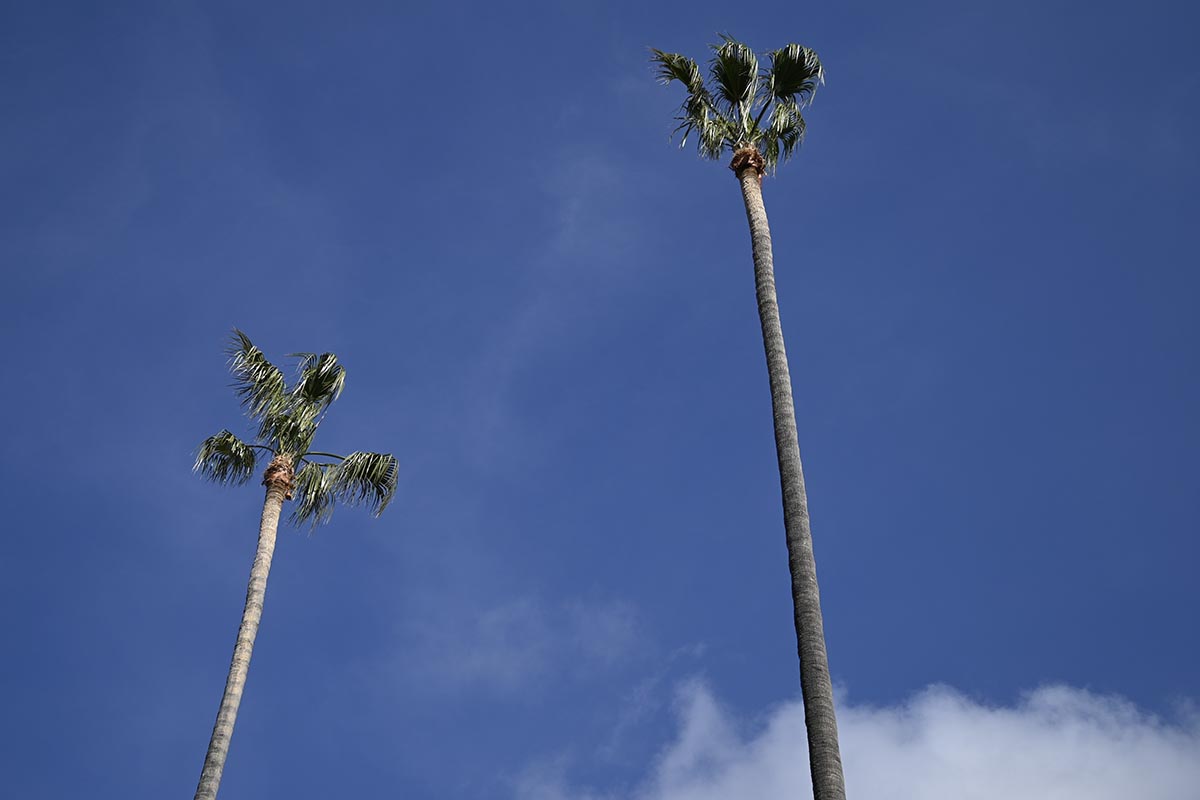
If you are growing it as a houseplant, the conditions should be bright, warm, and not humid.
It can be challenging to make your house as comfortable for this species as the sandy hills of Baja, California.
For this reason, W. robusta often does better on a warm, sunny patio from late spring through early fall, and then in a greenhouse or bright bay window for the duration of winter.
Even when grown in a pot this species can grow quite large, so make sure to get some help when moving the container to and fro.
Wherever you situate your plant, make sure it gets at least six hours of bright sunlight per day. Use a ceramic pot to encourage good drainage and aeration of the soil. Water thoroughly, but allow the soil to dry out to an inch down before watering again.
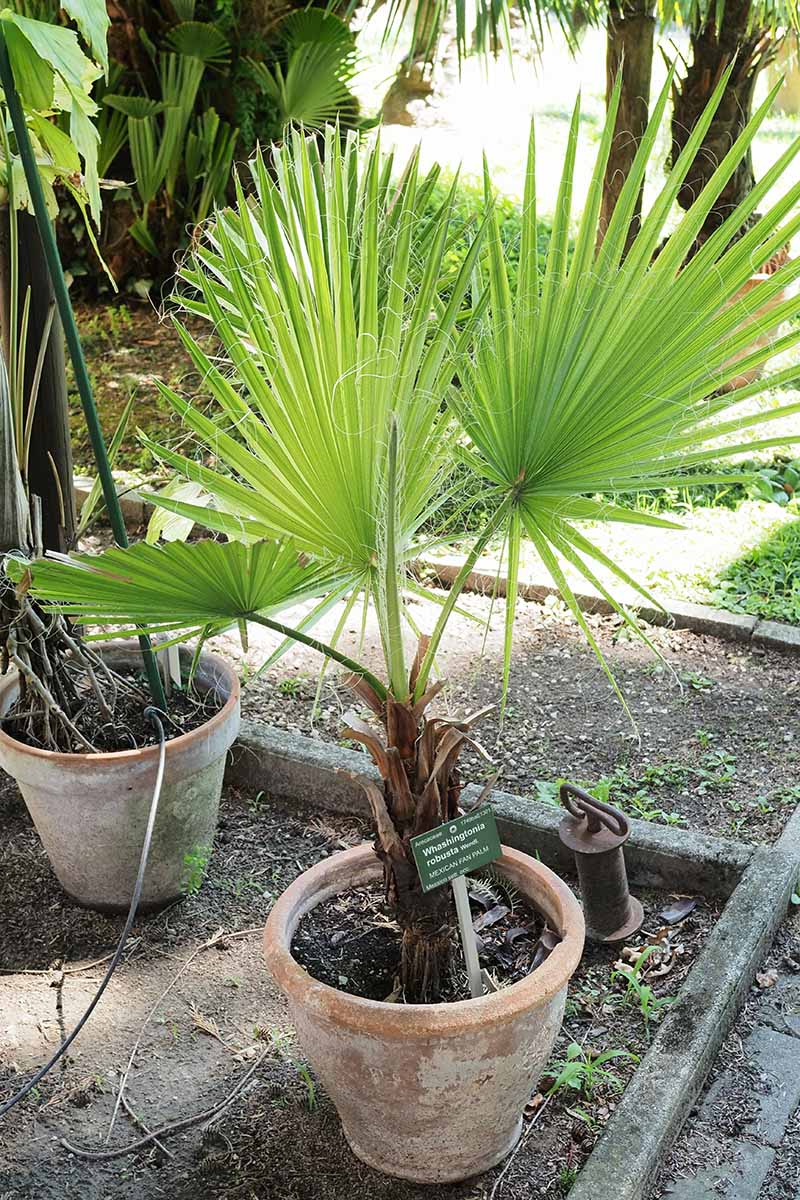
During winter, like many plants, this species enters a period of dormancy and slower growth.
Decrease watering at this time to avoid root rot and other fungal problems. You may only need to water once every three weeks though the winter, but this will depend on the placement of your tree and its individual needs.
Growing Tips
- Plant in freely draining soil.
- Site in a location with abundant sunlight.
- Provide plenty of space to grow.
- Avoid cramped or humid conditions which will invite fungal problems.
- Water once a week during the first six months after planting in the absence of rain and then only in dry spells.
Maintenance
Maintenance for an indoor W. robusta is a little more involved than for specimens living outside.
In the garden, you can mostly be blissfully hands-off once your Mexican fan palm is established.
If your plant is situated in freely draining soil, has plenty of space to stretch out, and is basking in ample sun, just stand back and enjoy!
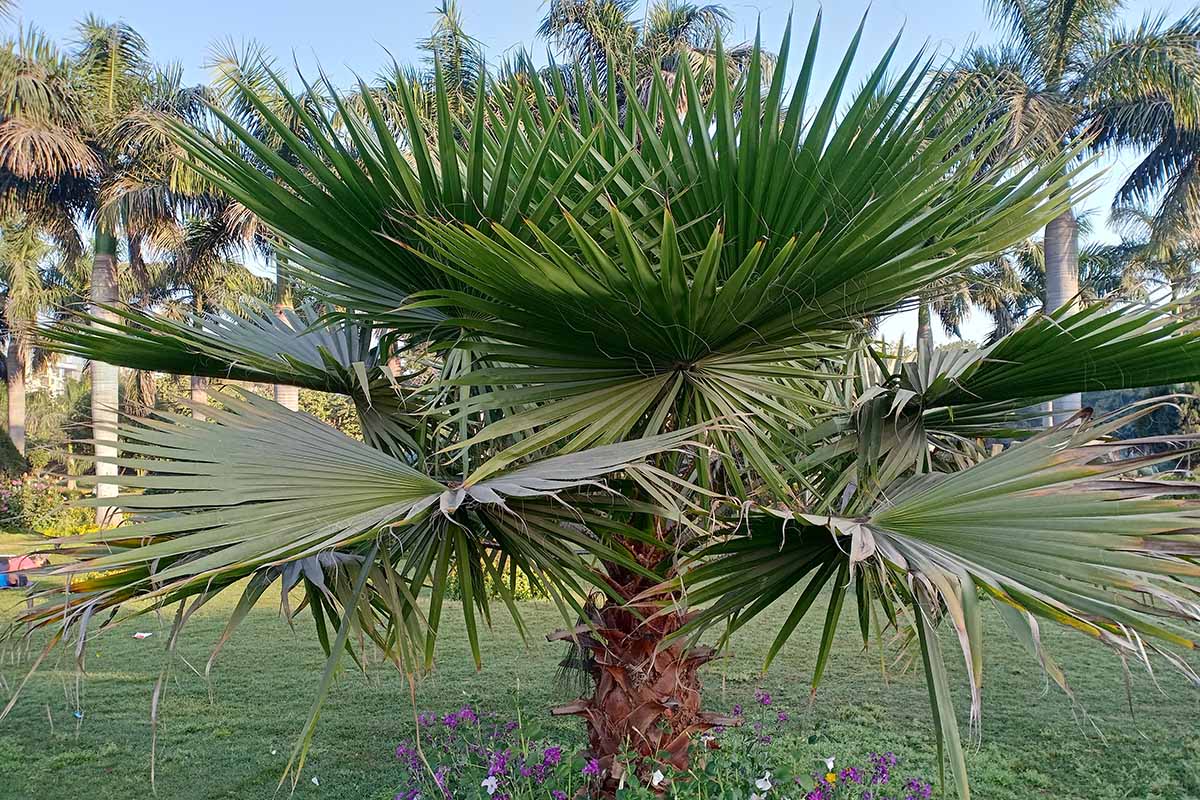
Indoor Mexican fan palms benefit from monthly doses of fertilizer during the growing season.
For best results, use a special palm tree food for monthly applications and make sure to water deeply after adding any kind of fertilizer to help nutrients trickle down to the roots.
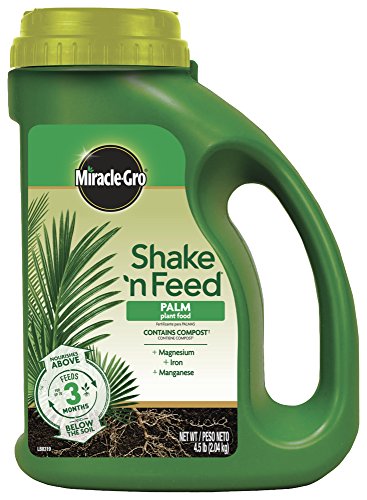
If you need a recommendation, Miracle-Gro has a palm-specific formula, available via Amazon.
If your outdoor tree is growing well without fertilization, feel free to leave it be – you can apply a top dressing of compost, several inches thick, once in spring and summer.
It’s not strictly necessary unless you see signs of nutrient deficiency such as sparse foliage or discolored blotches on the leaf tips.
Once this species prepares to enter dormancy in late fall, stop fertilization to avoid encouraging leggy growth.
Pruning Mexican fan palm fronds will rob this species of the iconic shaggy skirt that makes them so eye-catching.
However, if you’ve planted your tree outdoors in a high traffic area, prune dead fronds to stop them flying off in high winds and injuring passersby.
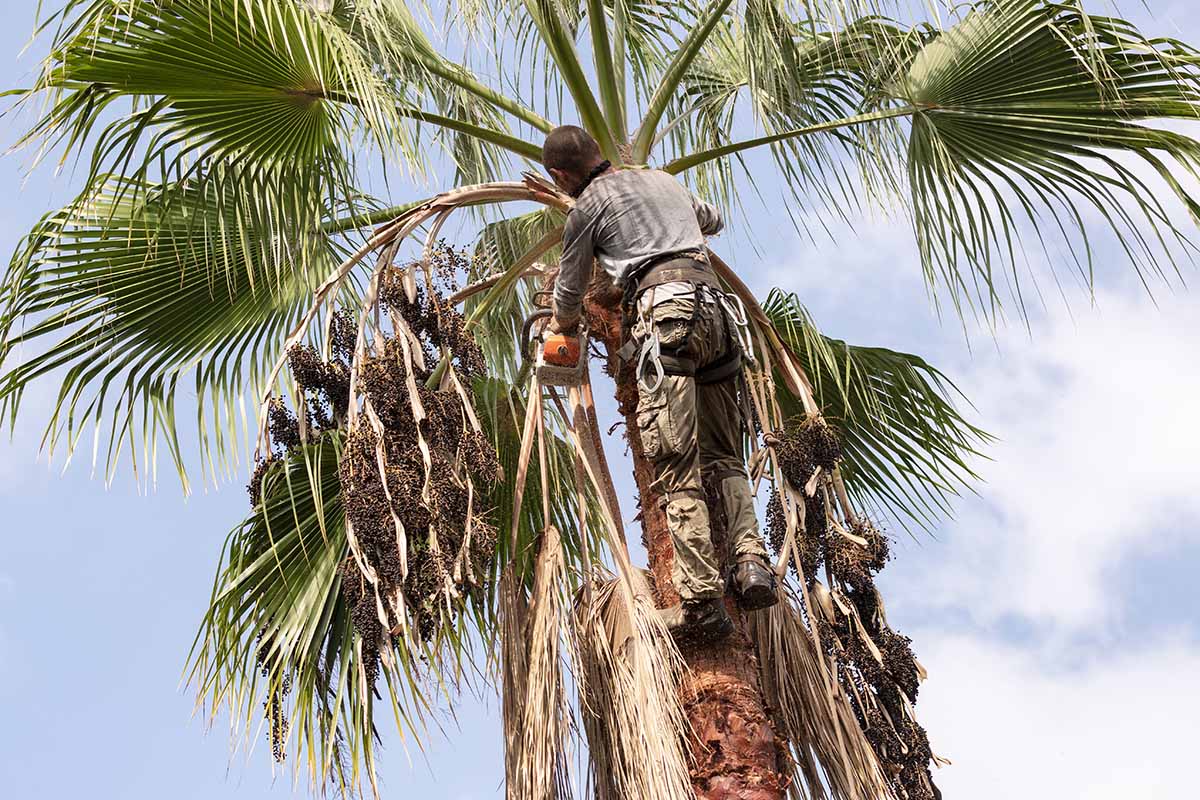
To cut off a dead frond, use a sharp pruning saw and remove it as close to the base as possible, without damaging the tree’s trunk.
If you are growing your specimen as a houseplant, it’s best to remove dead fronds as they wither.
Dead or diseased foliage in indoor conditions can create the perfect environment for pests to prosper. The same goes for any spent flowers or fruit.
Where to Buy Mexican Fan Palms
Mexican fan palm is available at many garden nurseries that carry a wide selection of indoor, or tropical plants.
If you can’t find one near you, Fast Growing Trees has them for sale online in three- and seven-gallon containers.
Managing Pests and Disease
Fortunately, the Mexican fan palm is as tough as they come.
Indoor specimens may suffer from an infestation of mealybugs or whiteflies if they are kept in cramped, poorly lit, or overly humid conditions. Outside, there’s not a lot to be worried about.
Pests
Here’s a general overview of some pests you might encounter outdoors:
Palm Leaf Skeletonizer
The larvae of the palm leaf skeletonizer moth (Homaledra sabalella) create large translucent blotches on W. robusta leaves and can cause leaves to die and drop off.
Keep your eyes peeled for the droppings of the caterpillars, which look like teeny black or green balls.
If you find them, wash the leaves vigorously with a strong stream of water from the hose and remove any that remain by hand.
Palm Weevils
Palm weevils in the Rhynchophorus genus can cause major damage to palms.
The adult weevils lay eggs in the crown of the palm and the larvae feed on soft, juicy bud tissue. Because these trees can only produce shoots that grow up, and not laterally, damage to the plant’s sole point of growth is often fatal.
If you manage to catch the infestation early, remove and destroy the insects and/or apply neem oil.
Many other types of palm weevils feed on the crown of these trees, however, none are as destructive as the invasive R. palmarum and R. ferrugineus.
Disease
Most of the common issues affecting Mexican fan palms are related to an overabundance of moisture.
Butt Rot
Butt rot is caused by the fungus Ganoderma zonatum, and as it progresses the trunk decays and gradually turns hollow.
Among the first signs of infection are drooping or yellowing leaves. Unfortunately, there is no cure for butt rot.
G. zonatum is commonly found in soils, and sadly, the only way to control this condition is to destroy all diseased plants and avoid planting palms in the same location.
This fungus can affect both indoor and outdoor specimens.
Fusarium wilt
The easiest to identify symptom of this disease, caused by the fungus Fusarium oxysporum, is the rapid death of older leaves.
At first, leaves appear to be affected only on one side of the midrib, but the fungus eventually spreads across the entire leaf, killing it.
Ultimately, this disease will kill the tree. Currently, there is no cure for fusarium wilt and it can affect both indoor and outdoor trees.
Phytophthora Bud Rot
Phytophthora palmivora is a water mold (oomycete) that kills tender, developing tissues in new leaves and buds. The first signs of infestation are discolored, wilting leaves.
This pathogen typically gains a foothold when trees are damaged by cold or physical trauma.
Unfortunately, there is no cure for this disease. Any affected plants and their soil should be destroyed, and not composted, to prevent further spread.
Young specimens are generally more susceptible than those that are well established.
Best Uses for Mexican Fan Palms
If you’re lucky enough to live somewhere where sunshine and warm weather is constant, use one of these quick-growing trees to really make a statement in your garden.
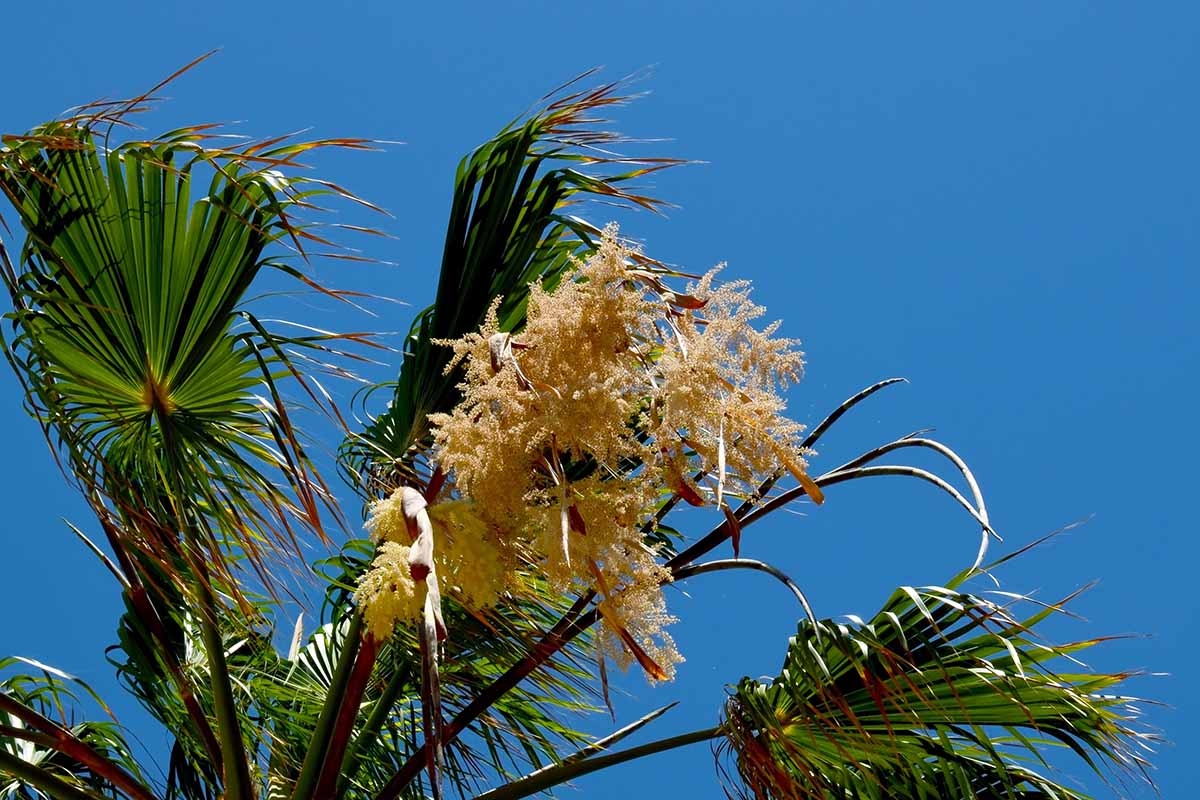
W. robusta is a hardy, unfussy, and all around excellent choice for a landscape tree of epic proportions.
Just bear in mind it will grow tall – very, very tall – and can be toppled more easily than smaller trees in high winds.
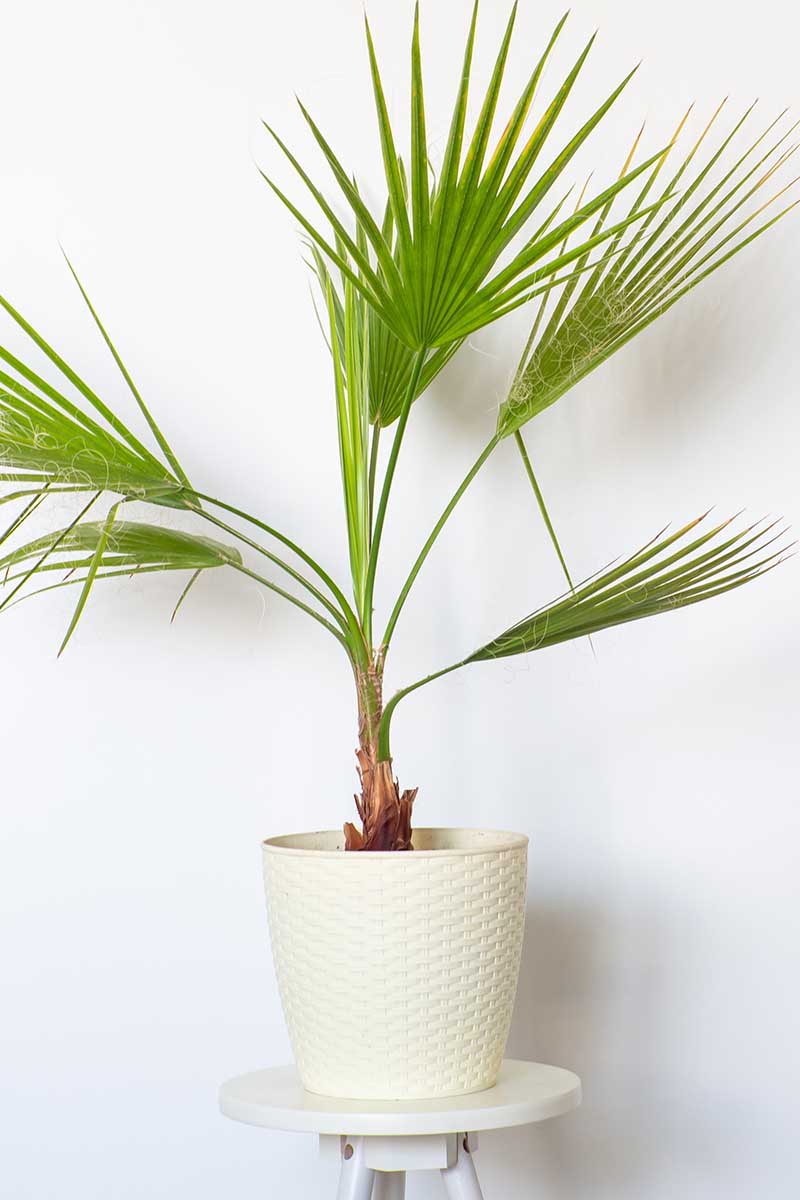
If you live in the colder climes but are longing for the warmth of Baja, try this adaptable tree in a pot, either indoors as a houseplant or a patio specimen with winter protection.
Quick Reference Growing Guide
| Plant Type: | Evergreen monocotyledonous perennial | Flower/Foliage Color: | Cream; light to dark green |
| Native to: | Mexico | Maintenance: | Low |
| Hardiness (USDA Zones): | 9-11 | Tolerance: | Drought, part shade, salt, soil compaction |
| Bloom Time: | Summer | Soil Type: | Loose, sandy to loamy |
| Exposure: | Full sun | Soil pH: | 6.0-7.0 |
| Spacing: | 25 feet or more | Soil Drainage: | Well-draining |
| Planting Depth: | Just below surface (seeds), depth of root system (transplants) | Uses: | Specimen tree, potted indoors or outdoors |
| Height: | Up to 100 feet | Order: | Arecales |
| Spread: | 15 feet | Family: | Arecaceae |
| Water Needs: | Low | Genera: | Washingtonia |
| Common Pests and Disease: | Palm leaf skeletonizer, palm weevils, tessellated scale; Bud rot, butt rot, false smut, leaf rot | Species | Robusta |
Mexican Fan Palm Fan Club
Nothing evokes the warm sun so vividly as the sight of palm fronds swaying in the breeze. Try this giant among palms in your garden or patio and let it transport you to somewhere tropical.

Are you part of the Mexican fan palm fan club? Let us know in the comments! And if you have any questions, we are happy to help.
If you want to learn more about growing and caring for palm trees, we have more information for you to read right here:

Is the fibrous trunk sheath below the base plate of each frond usefully for anything? Is it similar in makeup to coconut coir?
Hi Doug, the answer is yes! That fiber is very useful and was traditionally used in Mexico for making cordage. It’s incredibly tough and I think would be hard to shred down into something like coconut coir or similar without a machine.